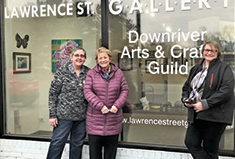Courney Spivak – Experimental Filmmaker with a Sensible Vision
To pursue the arts, you don’t need top-of-the-line materials. Nor do you have to study under a highly-skilled painter, fashion designer, or film director who proclaims, “You’re a genius!”
Just ask Ferndale resident Courtney Spivak—whose career in media resulted from
an ordinary school assignment. In 1995, during her sophomore year at Lamphere High School in Madison Heights, her French teacher unnerved her with the requirement to either give a speech or read a short literary selection in front of the class.
Spivak felt confident about her increasing fluency in French, but was shy then and dreaded public speaking. To get out of it, she chose to make a video of her presentation instead. “I knew a kid at school whose father owned an electronics repair shop and agreed to loan me a camcorder,” says Spivak. “My friend taped me reciting this flowery French poem. It was pretentious but fun.”
 With encouragement from her teacher, Spivak designed and starred in a series of short videos using different props and settings. Observing how well the vignettes entertained the class, her French teacher took Spivak aside one day and told her to consider video-making as her true calling.
With encouragement from her teacher, Spivak designed and starred in a series of short videos using different props and settings. Observing how well the vignettes entertained the class, her French teacher took Spivak aside one day and told her to consider video-making as her true calling.
Spivak’s parents also noticed their daughter had an affinity for making videos. “That December,” she says, “my parents bought me my own camcorder.
I spent my entire Christmas vacation recording anything I could—the sky, running water, my foot—it didn’t matter. I was consumed by it.”
Pleased by the enthusiasm, her parents bolstered her hobby with more purchases that winter: a TV monitor, two VCRs (one with just editing capabilities), and a “primitive” personal computer. Each week, she spent hours experimenting with the electronics. To create special effects for her videos, she learned how to manipulate different color filters and lenses onthe camcorder.
The quality of her recordings impressed her theatre arts teacher who taught the only video production class offered at Lamphere back in the 1990s. Since her theatre teacher didn’t know much about making videos, Spivak says he relied on to teach the other students how to use the editing equipment.
By senior year, she was eager to entertain a wider audience than teachers and classmates with her communication projects. The opportunity to try her hand at mass media came from Media One (now Comcast). The cable provider advertised training for anyone interested in hosting their own public-access show – Spivak signed up with three of her friends for the three-day instructional session.
As soon as Spivak and her friend received their certificates to operate the company’s video equipment, they hit the Ferndale and Royal Oak streets to find participants for the variety/community information show she called “Staticvision.” With her crew, she taped local band performances, interviewed artists and musicians, and spotlighted business owners.
To spice up the bi-monthly program, whose metro viewing area extending as far west as Keego Harbor, Spivak says, “We’d talk to and record street performers and groups of kids hanging out around Royal Oak. Watching us tape, some people would spontaneously come up to us and want to be interviewed. Often, they’d make funny remarks that added humor to the show.”
During the program’s two-year run, Spivak also immersed herself in other projects. After graduating from high school in 1998, she enrolled at Oakland Community College and took classes at the Royal Oak campus. In addition, she attended filmmaking and screenwriting classes offered through the Detroit Film Center (DFC), an organization sponsored by the Old Redford Theatre. Through the connections she made producing “Staticvision,” she secured a yearlong internship with a company filming local commercials.
After she transferred from OCC to Wayne State in 2000, her creativity soared to new heights. As an undergrad, she amassed numerous awards for her short-subject films. In 2003, her experimental won First Place in Comedy at Wayne State Media Festival; the following year, it received a debut screening at the Planet Ant Film Festival in Hamtramck. The judges of the Wayne State 2004 Moving Media Festival also heaped accolades on her next film which won First Place in the Narrative category.
 With a few scenes shot at Xhedos, now A. J.’s Café, on Nine Mile Road, takes place during one evening of a 20-year-old woman’s life. On the surface, the plot seems simple—the woman is disheartened because she’s just ended a relationship—yet the story line quickly gains momentum.
With a few scenes shot at Xhedos, now A. J.’s Café, on Nine Mile Road, takes place during one evening of a 20-year-old woman’s life. On the surface, the plot seems simple—the woman is disheartened because she’s just ended a relationship—yet the story line quickly gains momentum.
Says Spivak, “The woman feels isolated, and the people around her reinforce her loneliness because they keep ignoring her. Some moments in it are quite sad, others are comedic. The film is about the difficult moment when you must decide if you’ve made the right decision about breaking up with someone.”
The film closes with a cliffhanger. The former beau calls the woman at home. From the caller ID, she can tell it’s him. As she vacillates about whether or not to pick up the phone, the scene fades to black.
Enjoying her recognition at Wayne State, Spivak completed her bachelor’s degree in film studies there in 2005. The following year, she took a temporary job designing prop signs for the basketball feature film , partially shot around Detroit. Almost ten years to the date she took the Introduction to Film course at OCC, she taught that same class at Wayne State in 2008, while finishing her master’s degree at the university in media arts.
“I thought that teaching film classes,” says Spivak, “in addition to doing my own creative projects on the side, was the stable way to go.”
Although she still contemplates story lines for narrative films, her current focus has been on experimental pieces, in which traditional story plots and explicit meanings are missing. Viewers can interpret the themes of these movies in a variety of ways. Her contemporary influence is Michel Gondry, who has created avant-garde music videos for electronic and rock bands, including the Daft Punk and the now-defunct White Stripes. Spivak admires his work because of its dreamlike logic, technical creativity, and limited or no digital effects. “I’m in awe of his cleverness over pre-packaged polish,” she says. “Who would’ve thought of using Legos to animate a video? But that’s what he accomplished for the White Stripes.”
Most recently, Spivak received admiration for her very short film “Sequestered,” which she collaborated on with Detroit-based filmmaker Sean Hages. In 2009, the movie was the official selection at both the Detroit Shorts Festival and the Midwest 3 Minute Film Festival. The following year, Spivak and Hages traveled to Cannes, France, where it was screened at the (short film corner). An experimental work, “Sequestered” contrasts images of humanity with frames of objects in decay. As Spivak states, one interpretation of the contrasting format is society’s obsession with aging.
 Since 2008, Spivak has been an adjunct Henry Ford Community College telecommunications instructor, as well as a judge at film festivals and a guest speaker at film screening events. Every semester, she encounters students who question their talent and available resources for creating innovation videos.
Since 2008, Spivak has been an adjunct Henry Ford Community College telecommunications instructor, as well as a judge at film festivals and a guest speaker at film screening events. Every semester, she encounters students who question their talent and available resources for creating innovation videos.
Fortunately, she has words of wisdom that can apply to any artistic endeavor. Paraphrasing French filmmaker Jean Cocteau’s words, she advises them: “Don’t wait around for reinforcement from others, or until you have the right equipment or just the right inspirational moment. Jump in there and get your feet wet. Start creating something. Worry about perfection later.”
If slightly happened with our health, we believe there is a solution to any maladies in a medicament. What medicines do patients purchase online? Viagra which is used to treat impotency and other states connected to erectile dysfunction. Learn more about “sildenafil“. What people talk about “viagra stories“? The most substantial aspect you should look for is “sildenafil citrate“. Such problems commonly signal other problems: low libido or erectile disfunction can be the symptom a strong health problem such as soul trouble. Causes of sexual dysfunction include injury to the penis. Chronic disease, several medicaments, and a state called Peyronie’s disease can also cause sexual malfunction. Even though this physic is not for use in women, it is not known whether this therapy passes into breast milk.



